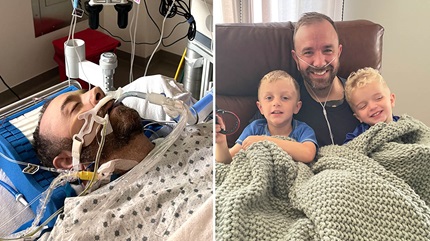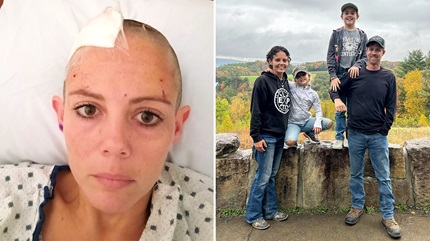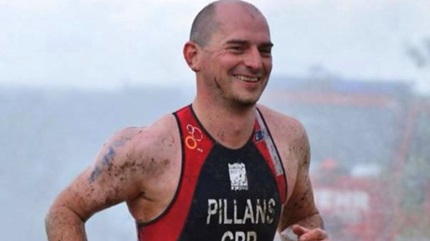Rick LeFeber ignored the pain in his left leg for two years. Thinking it was arthritis, the active 71-year-old mentioned it to his doctor at an annual physical. “It was a very sharp ache,” says Rick. “It felt like my leg was going to break.” He began having more difficulty standing and walking for long periods of time.
A Vietnam veteran, Rick spends his days managing more than 1,000 public acres in the Zaepfel Nature Sanctuary and along a 12-mile trail near his Village of Cattaraugus home in Western New York.
After an X-ray and MRI, he was referred to a bone specialist in Buffalo. The physician suspected chondrosarcoma, a rare form of bone cancer that affects less than 1,000 people in the United States every year. A diagnosis of the cancer in his left femur was confirmed after a biopsy.
“My wife and I went to the specialist with 25 questions,” says Rick, who was disappointed and frustrated when his questions went unanswered.
He left the doctor’s office on crutches to protect his fragile leg from breaking and spreading the cancer throughout his body.
"I went to Cleveland Clinic because they are on the leading edge and have the reputation of being the best."
Rick decided to get a second opinion. “I went to Cleveland Clinic because they are on the leading edge and have the reputation of being the best,” he says.
“The second opinion process is an important part of what we do in orthopaedic oncology,” says Nathan Mesko, MD, the Section Head of Orthopaedic Oncology and Trauma. “When you are first met with bad news, it’s a lot to digest, especially when the word cancer is brought up.”
All of Rick’s scans and patient information were sent to Cleveland Clinic.
“Dr. Mesko popped my scans on the screen and we went through them. It was a very caring, logical interaction,” says Rick.
“When you first are diagnosed with cancer, you go through a whole range of emotions – from shock to disbelief and fear,” says Dr. Mesko. “The best way to overcome fear is to ask questions because those answers tell you how you can proceed.”
Rick says all of his questions and more were answered.
“About 80 percent of Rick’s bone was infiltrated by cancer,” says Dr. Mesko. We usually have a bit more bone to work with after we take the cancer out.” He felt a customized prosthesis was needed because of the small amount of bone left to work with.
“Rick is very active and enjoys hiking,” says Dr. Mesko. “I was concerned we could run into problems, such as loosening, which would mean more surgery down the road.
“The extra effort to save that small amount of bone around the hip is important for our goal to salvage the limb, get the cancer out and make sure there’s nothing left behind.”
Dr. Mesko worked with an English company to produce a one-of-a-kind knee and femur prosthesis specific to Rick’s specifications. The prosthesis was ionized with silver to prevent disease and infection.
“We created a unique solution,” says Dr. Mesko. “In the operating room, we used navigation with a live CT scan. We mirror that with a computer program to make sure the implant fits exactly as planned.”
When Rich woke up following surgery, he moved his toes and touched his leg without pain. Cleveland Clinic staff had Rick up and walking the first day. By the end of the week he was able to go to a rehab facility.
“I went from being bedridden to a wheelchair, to a walker, to crutches, to a cane in three weeks,” says Rick. Rick is now cancer-free and back to managing his property.
“I started realizing all sorts of victories,” says Rick. “I took up spinning and can now spin up to 15 miles at a time.” He mowed trails, cut trees with a chain saw and shoveled snow as he had done one year earlier.
“It’s coming together. I feel like I’m ahead of the curve right now,” says Rick.
Dr. Mesko concurs with Rick’s assessment of his progress. He notes that Rick’s prosthesis remains intact; bone growth is providing a cement to keep it in place and prevent loosening in the future.
“To not only have the potential to cure someone, but also offer him the same function as he had before, is a unique aspect of the advances in surgical implants and cancer care,” says Dr. Mesko. “It’s the best part of my job.”
“Cleveland Clinic’s philosophy is ‘patients first,’ and I was never disappointed,” says Rick. “Everybody put out their very best for me.”
Based on his positive experience, Rick has joined Cleveland Clinic’s 4th Angel Mentoring Program, which provides the chance to support and encourage other patients with a similar diagnosis.
“This is an opportunity to influence people’s thinking on processes and procedures that will make them better,” says Rick. “I tell them ‘this will challenge you, but it’s not insurmountable.’ ”
Related Institutes: Cleveland Clinic Cancer Center, Orthopaedic & Rheumatologic InstitutePatient Stories
Tattoo Artist and Dad of Three Thankful for Life After Double-Lung Transplant
Apr 12, 2024
Woman With Young-Onset Parkinson’s Finds Relief After Deep Brain Stimulation
Apr 11, 2024
Triathlete shares remarkable recovery after quick treatment for lung cancer
Apr 10, 2024
“I am really impressed with Jeremy and Cleveland Clinic London,” says Andy. “I would recommend Cleveland Clinic London to anyone. If my cancer comes back, this is where I’ll come.”


